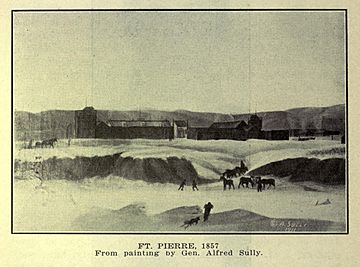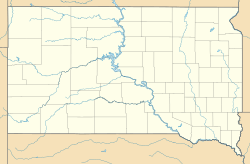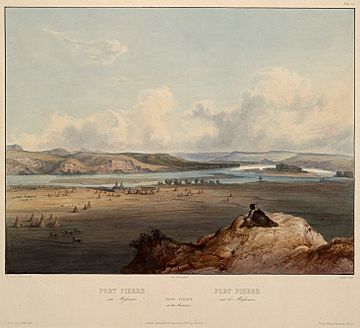Fort Pierre Chouteau facts for kids
|
Fort Pierre Chouteau Site
|
|

Fields at the site
|
|
| Nearest city | Fort Pierre, South Dakota |
|---|---|
| NRHP reference No. | 76001756 |
Quick facts for kids Significant dates |
|
| Added to NRHP | April 3, 1976 |
| Designated NHL | July 17, 1991 |
Fort Pierre Chouteau, often called Fort Pierre, was a very important trading post and military base. It was built in the mid-1800s on the west bank of the Missouri River. Today, this area is in central South Dakota.
Pierre Chouteau, Jr. from St. Louis, Missouri, built the fort in 1832. His family was well-known for trading furs. The fort was used until the 1850s. For many years, it was the biggest trading post in the northern Great Plains. It was a key place for sending buffalo furs to other places.
Today, you can find the old fort's remains in Stanley County. It is just north of the town of Fort Pierre. In 1991, these remains were named a National Historic Landmark.
Contents
Where Was Fort Pierre Chouteau Located?

Fort Pierre Chouteau was built just north of where the Missouri River meets the Bad River. It sat on a low, flat area above the Missouri River's west bank. This spot was very important for several reasons.
It was a middle point for the trading posts of the American Fur Company (AFC). By 1830, the AFC controlled most of the fur trade on the upper Missouri River. Fort Pierre was also the end point for a major land route to Fort Laramie. This fort is in what is now eastern Wyoming.
Fort Pierre was built to replace an older fort called Fort Tecumseh. That fort was on LaFramboise Island, closer to where the rivers met. Fort Tecumseh was built in 1817 by the Columbia Fur Company. This company was the AFC's earlier partner in the fur trade. The island fort was not in a good spot and often flooded. Some of its wooden parts were used to build Fort Pierre Chouteau.
The History of Fort Pierre
The first Europeans to meet Native Americans in the Fort Pierre area were French explorers. They were the La Vérendrye brothers. They explored the area in 1743–44. They buried a lead plate on a hill near the rivers. This plate claimed the land for the King of France.
The next important visitors were members of the American Lewis and Clark Expedition. They camped in the area in 1806. The U.S. government sent them to explore and map the Louisiana Purchase lands. This land was bought in 1803.
In 1817, a trader named Joseph La Framboise, Jr. set up a French-Canadian trading post here. His parents were fur traders from Quebec and Ontario. His mother was Métis and took over a post in Michilimackinac, Michigan, after her husband died. Joseph's trading post started the first permanent white settlement in the Missouri/Bad River area.
The Fur Trade and Fort Pierre
In 1822, some former fur traders from the British Hudson's Bay Company started the Columbia Fur Company. They built Fort Tecumseh and other posts on the Upper Missouri River. In 1827, John Jacob Astor bought the Columbia Fur Company. His American Fur Company almost controlled all the fur trade.
The AFC put Bernard Pratte and Pierre Chouteau, Jr. in charge of their Upper Missouri operations. In 1832, Chouteau traveled up the Missouri River on the first trip of the steamboat Yellowstone. He ordered the building of a new fort, which was named Fort Pierre in his honor.
Astor left the fur business in 1834. Chouteau then bought the Fort Pierre operation. He later bought out Pratte and became the main owner of this trading post.
Fort Pierre quickly grew into a major center for Chouteau's trading business. It was in a central spot for the company's supplies. Also, it was usually surrounded by Lakota Sioux and other Plains Indian tribes. These tribes traded buffalo furs for goods from America and Europe. At its busiest in the 1850s, Fort Pierre was part of a huge trading network. This network stretched from the Rocky Mountains to the Eastern United States and Europe. The company shipped 100,000 fur robes through Fort Pierre.
The End of the Fort
In the 1850s, the American bison, or buffalo, were hunted too much. This was partly because of the fur trade and high demand around the world. But it was also because American railroads were moving west. More people hunted buffalo for fun and killed as many as they could.
Pierre Chouteau sold the fort to the United States government in 1854. The government found the fort was not good enough. They left it in 1857 and moved to Fort Randall to the south. Any useful buildings and materials were taken to Fort Randall. Any wood left was used to fuel steamboats on the river. The trade in buffalo furs mostly ended by the early 1860s. This was when the United States Army set up a presence in the region.
What Happened After the Fort Closed?
Fort Pierre Chouteau became part of the reservation lands given to the Sioux. This happened with the Treaty of Fort Laramie of 1868. When the Dakota Territory was divided in 1889, the Sioux reservation became smaller. The fort's land then became available for homesteading.
The land was used for grazing animals until 1930. Then, the state of South Dakota bought it. The state's property grew even more with a land gift in 1970. Archaeological digs in the 1980s found parts of the fort's structure. This helped confirm where it was located.
Today, the site is an open field. It is just north of Fort Pierre, on the north side of Fort Chouteau Road. It was added to the National Register of Historic Places in 1976. It became a National Historic Landmark in 1991. A stone marker is in the middle of the site. You can reach it by a gravel path. There are no visible remains of the fort's buildings today. The state is planning to make it easier to visit and learn about the site.




